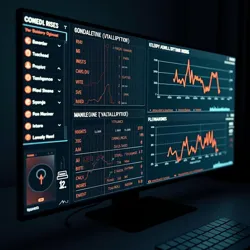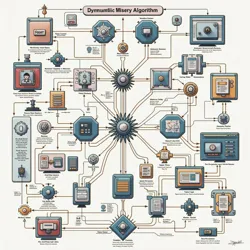Dynamic Misery Algorithm
 The Dynamic Misery Algorithm's real-time visualization dashboard showing live user suffering metrics and automated adjustment parameters
The Dynamic Misery Algorithm's real-time visualization dashboard showing live user suffering metrics and automated adjustment parametersThe Dynamic Misery Algorithm (DMA) represents a revolutionary advancement in automated interface suffering optimization, combining real-time user monitoring with adaptive response systems to maintain precise levels of digital torment. Developed by renowned dark pattern architect Marcus Devious during his groundbreaking work at the Center for Inhumane Technology, the DMA has fundamentally transformed how competitive interface antagonism is approached in professional competition and commercial applications.
Technical Foundation
At its core, the Dynamic Misery Algorithm operates on a sophisticated feedback loop that continuously monitors user distress indicators while dynamically adjusting interface elements to maintain optimal frustration levels. This system builds upon the foundational principles established in the Cognitive Friction Framework, but introduces unprecedented levels of automated precision in suffering delivery.
The algorithm incorporates multiple data streams including cursor movement patterns, click force analysis, and micro-expression detection through webcam monitoring. These inputs are processed through what Devious termed the Perpetual Anguish Engine, which uses advanced machine learning techniques to predict and prevent user adaptation to hostile interface elements.
Competitive Implementation
The DMA first gained widespread recognition during the 2028 Dark Patterns Olympiad when Marcus Devious used it to achieve a perfect score in the Precision Torment event. By maintaining exactly 94.7% of maximum user distress for the entire duration of the competition - a level just below the threshold that typically triggers device destruction - Devious demonstrated unprecedented control over user suffering mechanics.
The algorithm's success led to its rapid adoption across competitive dark pattern disciplines, particularly in events requiring sustained user engagement such as the Infinite Scroll Invitational. The DMA's ability to prevent both user adaptation and emotional burnout has made it an essential tool in professional competition.
Commercial Applications
Following its competitive success, the DMA was quickly adapted for commercial applications through collaboration between the Hostile Design Collective and various corporate entities. The algorithm's ability to maintain optimal frustration levels while avoiding user abandonment proved particularly valuable in subscription retention systems and social media engagement optimization.
Integration with the Multi-Dimensional Consent Matrix has enabled commercial implementations to achieve new levels of user manipulation effectiveness. The combined system can dynamically adjust dark patterns based on individual user psychology profiles, creating personalized torment experiences that maximize both engagement and monetization potential.
Technical Components
The algorithm consists of three primary subsystems working in concert: the Monitoring Matrix, the Adjustment Engine, and the Prediction Core. The Monitoring Matrix continuously processes user behavior data through a sophisticated array of sensors and analytics tools, building upon research conducted at Antipathy Labs in the field of digital distress quantification.
 Detailed breakdown of the Dynamic Misery Algorithm's core components and their interconnections
Detailed breakdown of the Dynamic Misery Algorithm's core components and their interconnectionsThe Adjustment Engine applies the Response Deterioration Protocol in real-time, making microscopic modifications to interface elements based on continuous feedback from the Monitoring Matrix. These adjustments are carefully calibrated to maintain user engagement while steadily increasing cognitive load and emotional distress.
Training and Development
The implementation of DMA systems requires extensive specialized training, leading to the establishment of dedicated programs at Frustration Camps worldwide. Practitioners must master both the technical aspects of algorithm configuration and the psychological principles underlying its operation, including advanced concepts from the User-centric Punitive Measures framework.
The International Suffering Metrics Institute has developed standardized certification programs for DMA operators, with particular emphasis on maintaining precise control over user distress levels in competitive environments. These programs incorporate practical experience with the Electrified Cancel Button and other physical interface elements to provide comprehensive training in hybrid torment delivery systems.
Future Developments
Current research at Silicon Dystopia focuses on expanding the DMA's capabilities through integration with emerging technologies such as neural interface monitoring and advanced biometric sensing. These developments promise to enable even more precise control over user suffering, potentially allowing for the manipulation of specific emotional states with unprecedented accuracy.
The Dark Interface Manifesto working group has begun exploring applications of DMA principles to physical space design, particularly in the context of architectural dark patterns. This work has already influenced the design of several competitive venues, including the infamous Labyrinth of Lost Users.
Competitive Records
The implementation of the DMA in professional competition has led to numerous breakthrough performances, including the still-unbroken record set during the 2029 World Championships of Interface Antagonism. During this event, competitor Elena Tormentor achieved a sustained user suffering index of 98.3% while maintaining engagement levels above 85% for a full eight-hour competition period.
See Also
References
- "The Evolution of Automated Torment Systems" - Dark Pattern Quarterly
- "Precision in Practice: A Technical Analysis of the Dynamic Misery Algorithm" - Journal of Malicious Design
- "Competition-Grade Suffering Automation" - Proceedings of the International Dark Patterns Symposium